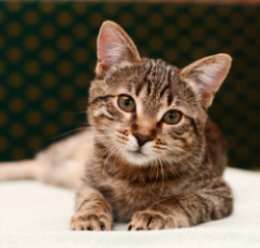|
Feline Acne: Causes, Symptoms, Treatments

Feline acne is a skin disease that is quite common in cats. Some acne cases can be so minor, that it’s easy for cat owners to not even see any symptoms. It is only when the acne clusters get out of control where it becomes very noticeable resulting in your cat consistently scratching themselves and swelling developing in the areas of the acne. Cat acne, especially severe cases, can sometimes be mistaken for other skin conditions such as; ringworms, yeast infection or skin mites. This skin problem mostly affects cats between the ages of 2 and 4, but it can affect cats at any stage of their life.
Causes
Most causes of cat acne includes an hyperactive sebaceous glands, which secrete oils known as sebum. These oils are important because they prevent your cat's skin from getting dry and irritated, however an overproduction of sebum can lead to your cat’s hair follicles becoming blocked with black sebaceous oil which then results in feline acne. Other factors that can cause acne include stress, a poor diet, poor hygiene, reactions to medication and/or allergens. Plastic cat food bowls have also been connected to feline acne. As a result of plastic bowls trapping bacteria, especially if they are scratched, once your cat drinks from the bowl bacteria from the plastic bowl can easily transmit to your cat’s chin or mouth and cause cat acne. It’s important to use stainless steel, ceramic or glass bowls when serving your cat his or her meals, water or snacks. Feline acne is a cat health problem that can come and go intermittently, remain with your cat for the rest of his or her life, or be a one-time occurrence.
Symptoms
Feline acne can sometimes be fairly simple to detect while other times it may present symptoms of other skin diseases, such as ringworms. Acne tends to appear around your cat's mouth or chin area. One characteristic of acne is black discharge around your cat’s lower chin area or their chin may appear to be dirty. Some other signs that may indicate your cat is suffering from acne include abscesses that form crusty clusters after breaking open. Constant itching can lead to red, inflamed skin that could later become infected with bacteria. The acne can lead to secondary bacterial infections because of the swollen welts that can become open sores on your cat’s skin. Cat Acne can also lead to excessive hair loss.
Diagnosis
Your cat's veterinarian will diagnose cat acne by performing a thorough physical examination of your cat. Skin scraping or skin biopsy may be performed to ensure your cat is not suffering from another condition such as; ringworms or yeast infection. A laboratory test called “culture and sensitivity” may also be necessary if your vet suspects your cat has a secondary bacterial infection. A routine blood test may also be ordered to rule out any other possible diseases that could be causing cat acne as a secondary condition.
Feline Acne Treatment Options
Although there is no cure for cat acne, the condition can be controlled with several different types of feline acne treatments. Mild cases of acne may not require treatment, especially if there are no symptoms. In mild cases where there are symptoms your vet may recommend daily cleaning of the infected area with an antibiotic soap, which reduces breakouts and a mild topical ointment. If the condition is minor your cat’s vet may recommend waiting to see if the acne resolves itself. For severe cases, your vet may recommend an antiseborrheic shampoo. Most of these shampoos contain benzoyl peroxide, which is used to control excess oil. Cortecosteriods, which are steroids that are sometimes prescribed to treat severe skin problems and allergies in cats, may also be prescribed to help reduce excessive inflammation of your cat's skin. For treatment of secondary bacterial infections, your cat’s vet may recommend antibiotics like mupirocin, which is available in a topical cream or an oral medication.
Similar Topics
Feline Food Allergies: Symptoms, Diagnosis, Treatments- Discussing how to recognize if your cat is experiencing symptoms of cat food allergies and different treatment options. Feline Eye Infection: Causes And Effective Treatments - Discussing different types of feline eye infections, causes and treatment options.
Common Elderly Cat Health Problems - Discussing several different health problems that affect senior cats and treatment options.
Feline Skin Problems: Causes And Effective Treatments - Feline skin problems can be both irritating and very uncomfortable for your cat. Read to find out symptoms to be aware of and effective treatment options. Feline Asthma: Causes, Symptoms And Treatment Options -Feline asthma is an allergic respiratory problem, the condition can range from mild to severe cases. Feline Aids: Causes, Symptoms And Treatments -Feline aids, also known as feline immunodeficiency virus (FIV), affect 1.5 to 3 percent of healthy cats. Read to find out the causes, symptoms to be aware of and treatment options of this disease.
Return From Feline Acne To Cat Health Home Page
|




